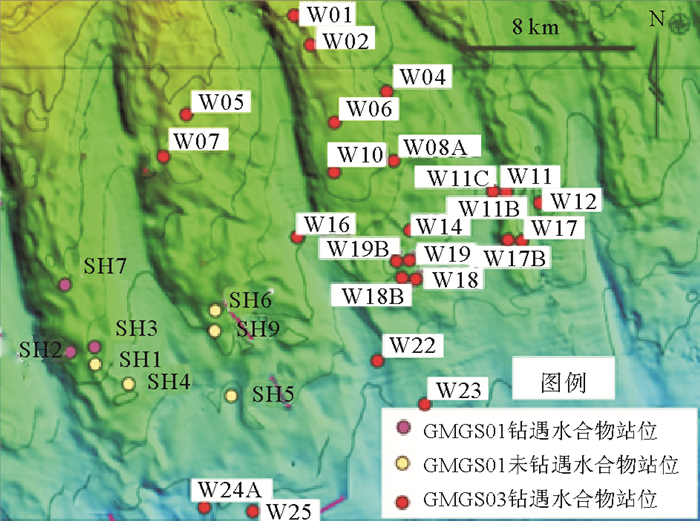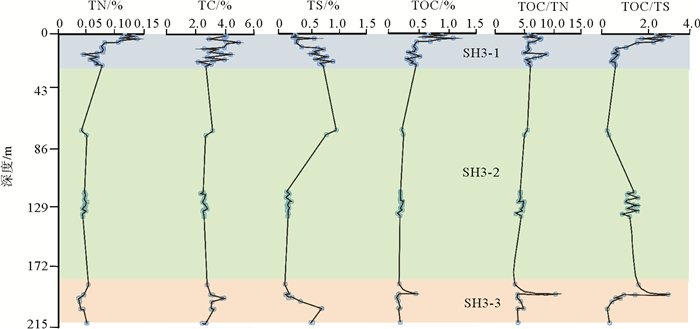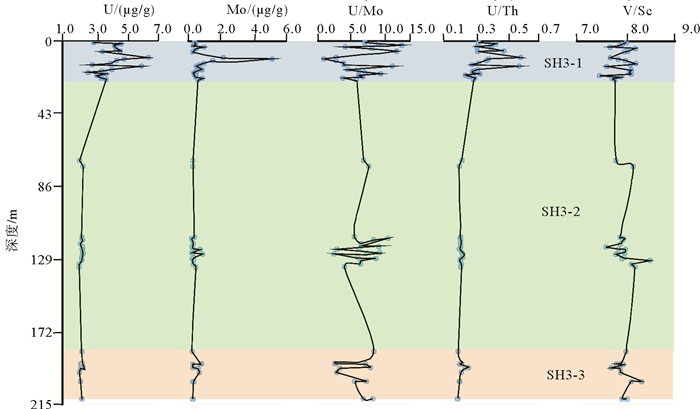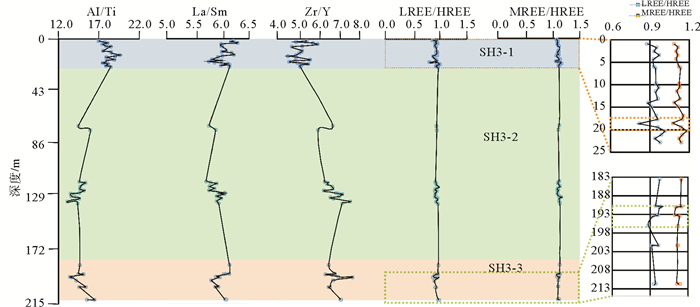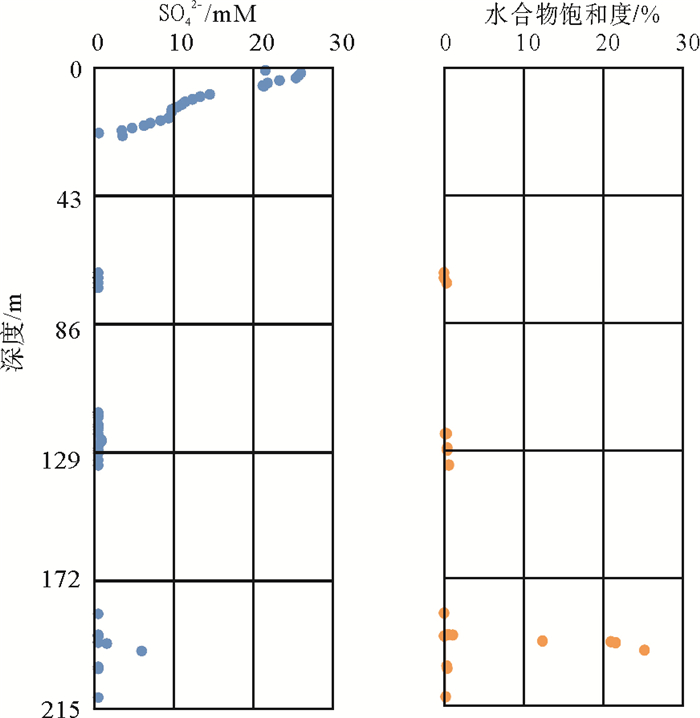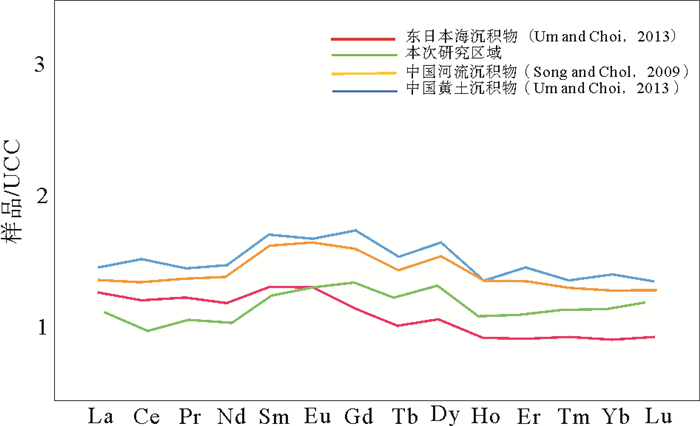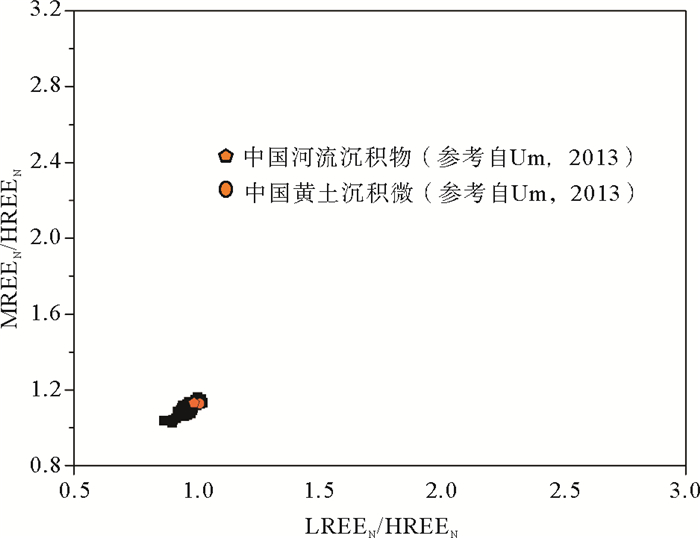GEOCHEMISTRY OF THE SEDIMENTS IN SHENHU HYDRATE DRILLING AREA, NORTHERN SOUTH CHINA SEA
-
摘要: 海底水合物形成分解/甲烷渗漏的甲烷以及相关的生物地球化学过程可能对海底的沉积环境产生影响,因此识别水合物的形成分解/甲烷渗漏对海洋沉积环境改造有助于了解水合物成藏特征及其形成分解过程。选取南海北部神狐海域2007年水合物钻探区的SH3钻孔沉积物为研究对象,对SH3钻孔岩心的碳硫数据、主微量元素,尤其是氧化还原敏感元素(U、Mo、U/Mo、V/Sr)进行分析测试,同时结合SH3钻孔孔隙水数据和前人对神狐水合物钻探区的研究成果等进行对比研究。结果表明南海北部神狐海域沉积物来源除河流沉积物以外,同时还有少量中国黄土以及大陆岛弧的长英质岩浆岩沉积物;通过对U、Mo、U/Mo以及碳硫数据分析,发现SH3钻孔在10~25 mbsf(meter below the seafloor)层位为硫酸盐驱动的甲烷厌氧氧化作用(Anaerobic oxidation of methane, AOM)造成的还原沉积环境,AOM作用导致了在这一层位发生了LREE/HREE、MREE/HREE的分馏;SH3钻孔沉积物在约180~215 mbsf的含水合物层位出现了浊流沉积的次氧化的沉积环境,同时其赋存的细粒沉积环境也导致了轻重稀土元素的分馏,与水合物饱和度存在一定的相关性。Abstract: The formation and decomposition of gas hydrate as well as the methane leakage caused by associated biogeochemical processes may change the depositional environment of the seabed. To identify the decomposition of hydrate as well as the change in marine environment caused by the seeping methane will contribute to the understanding of the processes of hydrate formation and decomposition. In this paper, we selected the Core SH3 as a case from the Shenhu hydrate drilling area in the northern part of South China Sea to study the formation and deterioration of hydrate. Carbon and sulfur contents, main and trace elements, especially redox sensitive elements are measured. Data from pore water and previous researches are also studied. The study suggests that the sediments of the Shenhu area are mainly sourced from a fluvial origin with a little of loess and felsic igneous materials. From the data of U, Mo contents and U/Mo ratio, as well as carbon and sulfur contents, it is inferred that the layers at 10~25 mbsf in the core of SH3 is mainly formed in a reduced depositional environment, resulted from sulfate reduction by the anaerobic oxidation of methane. The change in redox condition of depositional environment may lead to the fractionation of LREE/HREE and MREE/HREE in the layers. In the SH3 core sediment, there is a sub-oxidized depositional environment at the level of about 180~215 mbsf. It is supposed to be caused by the deposition of turbidites. The depositional environment of fine-grained sediments, at the same time, also leads to the fractionation of light and heavy rare earth elements. To sum up, we have succeeded in revealing material source, environment change in the Shenhu area and the specific role of hydrate-sedimentary environment in this paper and the results are very useful for understanding of the origin of gas hydrate.
-
Keywords:
- the Shenhu area /
- hydrate drilling area /
- gas hydrate /
- sedimentary environment
-
潮滩通常被定义为周期性被海水覆盖、以潮汐为主要作用力、沉积物组分主要为细颗粒物质的沿海地貌类型[1]。在潮滩区域,潮差的大小往往大于有效波高,滩面坡度较低且沉积物量较为丰富[2-3]。潮滩在全球气候变化和碳循环中扮演着重要的角色,同时在生态资源保护、土地规划以及抵御海洋灾害如极端事件等方面具有着重要的作用,具有较高的研究价值[4-8]。因此,开展潮滩相关的研究,尤其是对潮滩地貌动力过程的研究是相当必要的[9]。
潮滩地貌的演化过程在不同时间尺度下表现出不同的规律和特征,其主要原因是作用于潮滩的影响因素存在不同时间尺度下的变化规律。季节尺度下,影响潮滩的主要因素包括波浪[10]、潮差[11]、植被[12-13]、极端事件频率[14]以及河口径流量变化导致的沉积物供给变化[15]等。对于世界上不同地区的潮滩,其出现季节性变化的主要因素也各不相同。在较长时间尺度下,影响潮滩地貌的外动力还包括海平面上升[3]、植被覆盖[16]以及人类活动例如围垦等[17]。
江苏潮滩季节性变化的影响因素主要为风浪、极端事件频率和季节性的沉积物供给丰度变化[18-19]。在冬季和春季,江苏沿岸风浪较大,河流进入枯水期结合港口关闸保水使得沉积物供给减少;在夏季,江苏沿岸的风浪强度减小,但极端事件的频率有所上升。这些因素使得江苏潮滩的季节变化机制具有一定的复杂性。
年际尺度下,江苏潮滩的演化过程受到海洋环流、沉积物供给、人类活动以及植被覆盖等因素的影响。黄河北归与长江口南迁导致江苏潮滩已无巨量沉积物来源[20],沉积物供应丰度的变化会导致江苏潮滩的冲淤状态由原先的不断淤积向均衡态乃至侵蚀状态演变。围垦行为[7]与潮间带上部互花米草生长状况[16]同样会对潮滩地貌形态与冲淤变化产生影响。此外,以往的观点认为,江苏海岸北部的冲淤分界点位于射阳河口[21],江苏中部潮滩全年大部分时间处于淤积或稳定状态[11]。但随着沉积物供给的逐年减少,这些观点目前是否适用同样尚未清楚。
因此,对江苏潮滩的季节与年际变化规律和机制进行研究十分必要。为了明确江苏中部潮滩目前的冲淤现状,本研究在该区域选取了3条不同的跨岸剖面,于2017—2020年进行了多次野外观测,以探究江苏中部潮滩的季节性演化规律和年际冲淤演化趋势,并尝试给出初步原因。
1. 研究区域
江苏海岸长约954 km,北起绣针河口,南至长江口北支,其中泥质潮滩约占92%[22]。江苏海岸的泥质潮滩发育较为宽广,宽度1~10 km;潮滩坡度较为平缓,约1‰;潮滩沉积物主要成分为黏土、粉砂、极细砂等细颗粒沉积物。江苏泥质潮滩属于中-大潮差的开敞或半开敞型潮滩,潮汐类型主要为半日潮[9, 23]。江苏潮滩的潮汐作用主要由东海前进潮波和黄海旋转潮波控制,平均潮差为2~4 m。在江苏沿岸,弶港地区的潮差最大,可达5 m以上,同时潮差以弶港为中心,分别向南北方向逐渐减小。根据潮间带的侵蚀/淤积动态,可以将江苏海岸分为淤长型岸段(射阳河口至东灶港)和侵蚀型岸段(大板跳至射阳河口与东灶港至启东嘴)[21]。
本研究在江苏中部海岸选取了3条潮滩的潮间带剖面作为研究区域,由南到北分别命名为L2剖面、L3剖面和L5剖面(图1)。L2剖面位于竹港附近,大丰港南部约8 km处,观测区域为海堤至低潮水边线之间,长度约1.5~2 km;L3剖面位于新洋港与斗龙港之间,大丰港以北约20 km处,观测区域为盐沼前缘至低潮水边线之间,长度约1.2~1.8 km;L5剖面位于射阳河口以北约10 km处,观测区域为海堤至低潮水边线之间,长度约1.3~1.5 km。
研究区域的潮汐类型为正规半日潮,自南向北3处剖面的平均潮差大致为2.7、2.2和1.7 m[23]。在辐射沙脊掩蔽作用的影响下,该区域波浪规模总体较小,但具有较为明显的季节性变化特征。黄海南部的风浪波高在冬季约为1.9 m,夏季约为1.0 m[19];根据大丰港海洋观测站(33°26.7′N、120°47.6′E)的观测资料,秋冬季节(9月—次年2月)近岸波浪的有效波高为0.55 m,春夏季节(3—8月)近岸有效波高为0.42 m。可以看到,该研究区域的波浪规模存在冬季较大、夏季较小的特点。潮间带上部多为盐沼区域,多生长互花米草,沉积物以粉砂为主,并含有部分黏土;潮间带中下部为光滩区域,沉积物组成以粉砂和极细砂为主。
2. 研究方法
为了研究江苏中部潮滩地貌和沉积物组分的季节性变化特征,分别在2017年11月,2018年1月、3月、5月、7月、9月和11月对江苏中部潮滩的3条剖面(L2、L3和L5剖面)进行了为期一年、间隔为两个月的实地地貌观测。利用中海达V60 GNSS RTK(水平测量精度为1 cm,垂直测量精度为2 cm,坐标系设置为CGCS2000,高程为CGCS2000大地高程)对潮间带进行了位置和高程的高精度测量,每两个测量点的间距约为10 m。
观测时间选择在当天的低潮平潮期,L2和L5剖面的观测区域为海堤至水边线,L3剖面由于潮间带宽度较大,且潮间带上部盐沼区域植被生长较为茂盛,互花米草的高度约1.5 m,测量难度较高,故L3剖面观测区域改为盐沼前缘至水边线。
此外,为了研究江苏中部潮滩地貌的年际变化,分别在2019年12月和2020年10月对3条剖面(L2、L3和L5剖面)的坐标和高程进行了重复测量,测量方法与先前的实地观测保持一致。
L2、L3和L5剖面的滩面高程测量过程中,同时自高程测量起点开始每间隔100 m对潮间带表层沉积物采样,在粒度分析前,首先进行沉积物样品的预处理,称取适量样品加入0.05 mol/L六偏磷酸钠溶液浸泡样品24 h,将样品初步分散。然后采用英国Malvern 公司生产的Mastersizer 2000型激光粒度仪进行测试,Mastersizer 2000型激光粒度仪测量范围为0.02~2000 μm,误差小于1%。得到测量结果后利用矩法计算样品的粒径参数[24],包括平均粒径(ϕ),以及黏土(粒径<2 μm)、粉砂(粒径2~62.5 μm)和砂(粒径>62.5 μm)含量。
3. 结果
3.1 季节变化
L2剖面位于大丰港南侧8 km处 ,剖面形态呈上凸型,潮间带上部、中部和下部坡度分别约为0.4‰、0.8‰和3.5‰,潮间带宽度1.5~2 km,其2017—2018年的潮间带高程变化结果如图2所示。2017年11月—次年1月,滩面高程总体略有增长,淤积量<10 cm。1—3月,潮间带上部略有淤积,下部出现侵蚀,高程变化量15~20 cm。3—5月,潮间带高程整体较为稳定,变化幅度小于5 cm。5—9月,潮间带出现明显侵蚀,两次测量间侵蚀量最大可达25 cm。而在9—11月,滩面高程变化较小,淤积或侵蚀量均小于3 cm。
图3所示为L2剖面7次测量的潮滩表层沉积物的粒度参数分布情况。L2剖面表层沉积物粒径由陆向海呈现明显递增趋势,黏土与粉砂含量由陆向海逐渐减少,而砂含量逐渐增加。采样结果显示,2017年11月—2018年1月,平均粒径整体减小,ϕ值增大约0.4;砂含量整体减小约10%。2018年1—3月,潮间带上部平均粒径减小,ϕ值增大约0.2,砂含量基本稳定;潮间带下部平均粒径增大,ϕ值减小约0.3,砂含量增大约15%。3—5月,除潮间带上部略有波动外,表层沉积物粒径参数较为稳定。5—7月,平均粒径在潮间带上部增大,ϕ值减小约0.3,在潮间带下部变化较小;砂含量整体增大约10%。7—9月,平均粒径整体增大,ϕ值整体减小约0.2,砂含量整体变化较小。9—11月,平均粒径整体减小,ϕ值整体增大约0.4,砂含量整体减小约10%。
L3剖面位于大丰港北侧20 km处,观测区域剖面形态呈上凸型,潮间带中部和下部坡度分别约为0.5‰和1.9‰,潮间带光滩区域宽度1.2~1.8 km,其一年内的滩面高程变化结果如图4所示。2017年11月—次年1月,滩面高度整体有明显下降,降幅达到20 cm。1—3月,潮间带高程较为稳定。3—9月,滩面高程基本处于明显侵蚀状态,相邻两次测量期间侵蚀量为15 cm 至50 cm不等。9—11月,潮间带不同位置出现不同的冲淤现象,在光滩的上半部分出现明显侵蚀,侵蚀量可达14 cm,光滩下半部分则有明显淤积,滩面高程最大增幅约为23 cm。
图5所示为L3剖面7次测量时潮滩表层沉积物的粒度参数分布情况。L3剖面表层沉积物粒径由陆向海呈现明显递增趋势,黏土与粉砂含量由陆向海逐渐减少,而砂含量逐渐增加。采样分析结果显示,2017年11月—次年1月,平均粒径整体减小,ϕ值整体增大约0.3,砂含量整体减小约10%。1—3月,平均粒径整体增大,ϕ值整体减小约0.4,砂含量整体增大约8%。3—5月,平均粒径在光滩上部减小,ϕ值增大约1.0,在光滩下部变化较小;砂含量整体减小约7%。5—7月,光滩上部平均粒径增大,ϕ值减小约1.3,光滩下部平均粒径变化较小;砂含量整体增大约6%。7—9月,光滩上部平均粒径减小,ϕ值增大0.6,砂含量减小约7%;光滩下部平均粒径变化较小,砂含量增大约5%。9—11月,平均粒径整体略微增大,ϕ值减小0.1;砂含量整体变化较小。
L5剖面位于射阳河口以北10 km处,剖面形态呈上凸型,潮间带上部、中部和下部坡度分别约为0.6‰、0.8‰和2.4‰,潮间带宽度1.3~1.5 km,其一年内的滩面高程变化结果如图6所示。可以看到,2017年11月—次年5月潮间带整体较为稳定,滩面高程变化量不超过7 cm。5—9月,潮间带上部未出现明显高程变化,潮间带下部出现了轻微侵蚀,但每两次测量间高程降幅均不超过10 cm。9—11月,潮间带上部轻微淤积,下部轻微侵蚀,淤积量不超过8 cm,侵蚀量不超过4 cm。
图7所示为L5剖面7次测量时潮滩表层沉积物的粒度参数分布情况。L5剖面表层沉积物粒径由陆向海呈现明显递增趋势,黏土与粉砂含量由陆向海逐渐减少,而砂含量逐渐增加。采样分析结果显示,2017年11月—次年1月,平均粒径变化较小,砂含量在潮间带上部增大约8 %,在潮间带下部减小约10%。1—3月,平均粒径整体变化较小;砂含量整体增大约5%。3—5月,平均粒径整体增大,ϕ值整体减小约0.4;砂含量整体增大约10%。5—7月,潮间带上部平均粒径整体减小,ϕ值增大约0.2,潮间带下部平均粒径变化较小;砂含量整体增大约2%。7—9月,平均粒径整体增大,ϕ值减小约0.4;砂含量整体增大约15%。9—11月,平均粒径在潮间带上部变化较小,在潮间带下部减小,ϕ值增大约0.3;砂含量整体减小约12%。
3.2 年际变化
在2017—2020年,对L2、L3和L5剖面进行了时间间隔为1年、共计4次的重复野外观测。测量时间分别为2017年11月、2018年11月、2019年12月和2020年10月,均在秋季,以消除季节性变化影响。4年的滩面高程测量结果见图8。
![]() 图 8 江苏中部潮滩2017—2020年高程变化结果a:L2剖面高程变化,横坐标0点为海堤处;b:L3剖面高程变化,横坐标0点为盐沼前缘;c:L5剖面高程变化,横坐标0点为海堤处。Figure 8. Elevation changes of the middle Jiangsu coast from 2017 to 2020a: Elevation changes of L2 Profile. The 0 point at x-coordinate is the position of seawall; b: elevation changes of L3 Profile. The 0 point at x-coordinate marks the salt marsh margin; c: elevation changes of L5 Profile. The 0 point at x-coordinate marks the position of seawall.
图 8 江苏中部潮滩2017—2020年高程变化结果a:L2剖面高程变化,横坐标0点为海堤处;b:L3剖面高程变化,横坐标0点为盐沼前缘;c:L5剖面高程变化,横坐标0点为海堤处。Figure 8. Elevation changes of the middle Jiangsu coast from 2017 to 2020a: Elevation changes of L2 Profile. The 0 point at x-coordinate is the position of seawall; b: elevation changes of L3 Profile. The 0 point at x-coordinate marks the salt marsh margin; c: elevation changes of L5 Profile. The 0 point at x-coordinate marks the position of seawall.L2剖面的滩面高程变化结果如图8a所示。2017—2018年,滩面高程整体出现下降,降幅在5 cm至20 cm不等。2018—2019年,潮间带整体出现明显淤涨,涨幅最大达22 cm。2019— 2020年,潮间带上部滩面高程较为稳定;潮间带中部出现侵蚀,滩面高程最大下降10 cm;潮间带下部出现淤涨,涨幅约为10 cm。
L3剖面的滩面高程变化结果如图8b所示。2017—2018年,滩面高程整体出现明显的下降,降幅最大达到50 cm以上。2018—2019年,滩面高程整体增加,盐沼前缘和水边线位置增幅最为明显,可达25 cm以上。2019—2020年,滩面高程整体出现明显下降,降幅最大达到92 cm。
L5剖面的滩面高程变化结果如图8c所示。分别对4次测量结果进行比较,2017—2018年,潮间带整体呈现上部淤积、下部侵蚀的现象,淤积和侵蚀量均在15 cm以内。2018—2019年,潮间带整体淤积,滩面高程最大增幅约为19 cm。2019—2020年,滩面高程整体出现下降,潮间带上部滩面高程降幅较小,约为4 cm,潮间带中下部滩面高程下降较为明显,最大降幅达到32 cm。
4. 讨论
4.1 季节性变化规律
剖面形态上,三条剖面的形态均为上凸型;粒度参数上,表层沉积物黏土含量和粉砂含量均表现出向海方向的递减趋势,而平均粒径和砂含量在向海方向表现出了递增趋势,这说明研究区域符合以潮汐作用为主动力的泥质海滩特征[3]。
L2剖面测量结果显示,在秋季和冬季初期,滩面高程处在较为稳定的状态。在冬季中后期,滩面上部淤积、下部侵蚀,整体坡度增大;春季初期滩面高程变化幅度较小;而在春季末期和整个夏季,潮间带滩面高程出现了明显的侵蚀或上部淤积、下部侵蚀现象。
可以发现,在秋季和春季,潮间带滩面较为稳定,这说明在这段时间研究区域的水动力条件和沉积物供给等条件的作用趋于平衡,使得潮间带处于近似均衡状态[3, 25]。而冬季出现了较为明显的上部淤积、下部侵蚀的现象,根据前人研究[3, 26],当波浪增大时,潮间带滩面会出现上部淤积、下部侵蚀的现象,结合江苏中部潮滩当地的水文特征,冬季波浪相对夏季更大,因此推测L2剖面冬季变化的原因可能为波浪的季节性增大。在夏季,潮间带出现整体侵蚀或上部淤积、下部侵蚀的现象,由于研究区域夏季波浪会明显减小,因此推测形成此现象的原因可能是夏季出现的极端事件如风暴潮等在短时间内增大了该区域的水动力条件,使得潮滩整体底床切应力增大,从而造成了明显的侵蚀作用。
L3剖面测量结果显示,L3剖面在全年基本处于侵蚀状态,其中,在夏季的侵蚀量较为明显。这说明该区域的滩面已经由原先的增长状态[22]越过均衡态,达到了侵蚀状态,其主要原因可能是沉积物供给的缺失。江苏中部潮滩的沉积物供给的主要来源是废黄河口[27],废黄河口原先堆积的沉积物被侵蚀,并由沿岸流自北向南输运,在江苏中部潮滩沉降和淤积。但由于1855年之后,黄河北归,使得废黄河口泥沙供给来源大幅减少,经过长时间的侵蚀过程之后,由南向北输运的沉积物量逐渐减少。这可能是L3剖面全年处于侵蚀的主要原因。另外,在夏季L3剖面的侵蚀最为剧烈,其原因可能与L2剖面相同,为夏季极端天气作用的结果。
L5剖面测量结果显示,除11月—次年1月外,L5剖面全年基本处于潮间带上部淤积或稳定、下部侵蚀的状态,同时全年各个季节的侵蚀量均较小。L5剖面位于高抒和朱大奎[21]指出的江苏海岸冲淤界限以北,2017—2018年的观测期间仍然处于侵蚀状态,但是速率已经较低,可能说明L5剖面在强烈侵蚀后接近新的均衡态。
龚政等[11]在2012—2013年对江苏王港潮滩进行了地形观测,观测区域位于L2剖面沿岸向南约10 km处。其结果显示,在全年的春夏秋3个季节,潮间带的大部分区域均处于淤积或稳定的状态。该测量结果与本文中相近地区的测量结果差异较大,其原因可能有两方面:① 本研究中在夏季潮间带出现侵蚀是由于受到了当年夏季多次台风风暴潮事件的影响,根据国家海洋预报台的风暴潮警报,2018年7—10月,研究区域共经历5次增水30 cm以上的风暴潮事件,而前人的研究过程中并未发生明显的风暴潮事件;② 龚政等[11]的野外观测时间为2012—2013年,其研究结果符合高抒和朱大奎[21]对江苏潮滩侵蚀/淤积区域的划分,其研究结果中潮间带区域明显处于淤积状态。在本研究中,除去夏季风暴作用的影响,L2剖面事实上处于相对稳定的状态。这从另一方面说明了来自废黄河口的沉积物供给在逐年减少,使得江苏中部潮滩由淤积状态向侵蚀状态过渡。
结合上述推测对江苏中部潮滩的季节性变化规律及其机制进行总结:① 大丰港以北的潮滩全年基本处于侵蚀状态,这可能是沉积物供给减少导致的结果;② 大丰港以南的L2剖面在春秋两季较为稳定,冬季可能由于波浪的季节性增强导致出现潮间带上部淤积、下部侵蚀的现象;③ 夏季的极端事件如风暴潮可能会对潮滩造成明显的侵蚀作用;④ 江苏潮滩北部的侵蚀/淤积区域分界点可能已经从射阳河口向南转移至大丰港南部区域。
4.2 年际变化规律
除了季节性变化外,在2017—2020年对L2、L3和L5剖面进行了每年一次的重复观测,以探究江苏中部潮滩的年际变化趋势。其测量结果显示,3条剖面在2017—2020年的潮间带滩面高程变化规律出现较为明显的一致性:2017—2018年,L2和L3剖面均出现整体侵蚀的现象,L5剖面则出现上部淤积、下部侵蚀的现象;2018—2019年,3条剖面潮间带高程均出现不同程度的上涨;2019—2020年,3条剖面均出现潮间带上部稳定或轻微侵蚀、下部明显侵蚀的现象。
总体来看,观测区域中L2剖面和L5剖面冲淤状态相对稳定,L3剖面处于强烈侵蚀状态。结合前人的观测数据,L5剖面以往位于侵蚀/淤积分界点附近,在经历侵蚀之后逐渐接近新均衡态;L3剖面以往处于淤积状态,随着侵蚀/淤积分界点南移,L3剖面转变为强烈的侵蚀状态;L2剖面以往处于淤积状态,目前处于相对均衡的状态,说明侵蚀/淤积分界点可能已经南移至L2剖面附近。
当前的观测结果为进一步研究该区域不同时间尺度下的冲淤变化提供了关键数据支撑。由于江苏海岸的海洋环流、波浪条件以及极端事件强度、频率等水动力条件逐年发生变化,江苏中部潮滩冲淤状态的年际变化可能与之存在不同程度的关联。未来将对以上影响因素进行进一步观测,并试图探究这些影响因素对江苏中部潮滩地貌年际变化的作用机制。
5. 结论
(1)大丰港以北潮滩在2017—2018年基本处于侵蚀状态,这可能是沉积物供给减少导致的结果。
(2)大丰港以南潮滩在2017—2018年春秋两季较为稳定,冬季可能由于波浪的季节性增强导致出现潮间带上部淤积、下部侵蚀的现象。
(3)夏季的极端事件如风暴潮可能会对三条剖面均造成明显的侵蚀作用。
(4)江苏潮滩北部的侵蚀/淤积区域分界点可能已经从射阳河口向南转移至大丰港南部区域。
(5)2017—2020年,江苏中部潮滩表现出较为一致的变化规律:2017—2018年,大丰港附近潮滩均出现整体侵蚀的现象,射阳河口潮滩则出现潮间带上部淤积、下部侵蚀的现象;2018— 2019年,江苏中部潮滩潮间带高程均出现不同程度的上涨;2019—2020年,江苏中部潮滩均出现潮间带上部稳定或轻微侵蚀、下部明显侵蚀现象。这可能与沉积物供给的变化以及江苏海岸的海洋环流、波浪条件以及极端事件强度、频率等水动力条件逐年变化有关。
致谢: 本次研究样品由广州海洋地质调查局于2007年在南海北部陆坡神狐海域实施“中国海域天然气水合物钻探”(GMGS1)航次钻探获取,感谢该航次科学家们为研究样品的采集付出的辛勤劳动;感谢中国科学院广州能源研究所分析测试中心、武汉上谱分析科技有限责任公司和中国科学院广州地球化学研究所为本文研究提供的测试;感谢两位评审专家提出的宝贵意见。 -
图 1 南海北部神狐海域水合物钻孔分布图
本文研究的站位为SH3钻孔[4]
Figure 1. Map showing the locations of the sediment core in this study
图 5 SH3钻孔孔隙水中SO42-离子浓度随深度的变化图(a)及SH3钻孔水合物饱和度随深度的分布(b)
(数据来自:GMGS1: Measuring the Concentration, Nature, and Distribution of Gas Hydrate, Geotek Field Report, 12 June, 2007)
Figure 5. Variation in SO42- concentration with depth in SH3 pore water (a), and hydrate saturation with depth distribution in the SH3 Drilling core (b)
(Data from GMGS1: Measuring the Concentration, Nature, and Distribution of Gas Hydrate, Geotek Field Report, 12 June, 2007)
表 1 SH3钻孔主要稀土元素特征与主要构造环境对比
Table 1 Major provenance types and corresponding elemental characteristics used to define the tectonic setting of the SH3
-
[1] Wu S, Zhang G, Huang Y, et al. Gas hydrate occurrence on the continental slope of the northern South China Sea[J]. Marine and Petroleum Geology, 2005, 22(3): 403-412. doi: 10.1016/j.marpetgeo.2004.11.006
[2] 吴能友, 张光学, 梁金强, 等.南海北部陆坡天然气水合物研究进展(英文)[J].新能源进展, 2013, 1(1): 80-94. doi: 10.3969/j.issn.2095-560X.2013.01.008 WU Nengyou, ZHANG Guangxue, LIANG Jingqiang, et al. Progress of gas hydrate research in northern South China Sea[J]Progress of Gas Hydrate Research in Northern South China Sea, 2013, 1 (1): 80-94. doi: 10.3969/j.issn.2095-560X.2013.01.008
[3] Zhang H Q, Yang S X, Wu N Y, et al. Successful and surprising results for China's first gas hydrate drilling expedition[C]//Fire in the Ice: Methane Hydrate Newsletter. Washington D C: Natl. Energy Technol. Lab., U.S. Dep. of Energy, 2007.
[4] Zhang G X, Yang S X, Zhang M, et al. Melanie Holland, Peter Schultheiss, and the GMGS2 Science Team, GMGS2 expedition investigates rich and complex gas hydrate environment in the South China Sea[J]. Fire in the Ice, Methane Hydrate Newsletter, 2014, 14(1): 1-5. doi: 10.1016/j.jseaes.2014.05.004
[5] Yang S X, Zhang M, Liang J Q, et al. Preliminary results of China's third gas hydrate drilling expedition: A critical step from discovery to development in the South China Sea[J]. Fire in the Ice, Methane Hydrate Newsletter, 2015, 15(12): 1-5.
[6] Yang S X, Liang J Q, Lei Y, et al. GMGS4 gas hydrate drilling expedition in the South China Sea[J]. Fire in the Ice, Methane Hydrate Newsletter, 2017, 17(1): 7-11.
[7] Zhong G F, Liang J, Guo Y, et al. Integrated core-log facies analysis and depositional model of the gas hydrate-bearing sediments in the northeastern continental slope, South China Sea[J]. Marine and Petroleum Geology, 2017, 86: 1159-1172. doi: 10.1016/j.marpetgeo.2017.07.012
[8] Li D L, Li R X, Zhu Z W, et al. Origin of organic matter and paleo-sedimentary environment reconstruction of the Triassic oil shale in Tongchuan City, southern Ordos Basin (China)[J]. Fuel, 2017, 208: 223-235. doi: 10.1016/j.fuel.2017.07.008
[9] Chen H T, Wang M C, Chang K M, et al. Phase transformation and morphology of calcium phosphate prepared by electrochemical deposition process through alkali treatment and calcination[J]. Metallurgical and Materials Transactions A, 2014, 45(4): 2260-2269. doi: 10.1007/s11661-013-2115-y
[10] Li N, Feng D, Chen L Y, et al. Compositions of foraminifera-rich turbidite sediments from the Shenhu area on the northern slope of the South China Sea: Implication for the presence of deep water bottom currents[J]. Journal of Asian Earth Sciences, 2017, 138: 148-160. doi: 10.1016/j.jseaes.2017.02.010
[11] Song H B, Osamu M, Yang S X, et al. Physical property models of gas hydrate-bearing sediments and AVA character of bottom simulating reflector[J]. Chinese Journal Of Geophysics, 2002, 45(4): 569-579. doi: 10.1002/cjg2.270
[12] Lu Z Q, Zhu Y H, Zhang Y Q, et al. Estimation method of gas hydrate resources in the Qilian Mountain permafrost area, Qinghai, China-A case of the drilling area[J]. Geological Bulletin of China, 2010, 29(9): 1310-1318. doi: 10.3724/SP.J.1231.2010.06586
[13] Um I K, Choi M S, Bahk J J, et al. Discrimination of sediment provenance using rare earth elements in the Ulleung Basin, East/Japan Sea[J]. Marine Geology, 2002, 346: 208-219. doi: 10.1016/j.margeo.2013.09.007
[14] Zhu L Q, Liu D, Hu J, et al. "GSK-3β Inhibits presynaptic vesicle exocytosis by phosphorylating P/Q-type calcium channel and interrupting SNARE complex formation[J] Journal of Neuroscience, 2010, 30(10): 3624-3633. doi: 10.1523/JNEUROSCI.5223-09.2010
[15] 吴能友, 张海啟, 杨胜雄, 等.南海神狐海域天然气水合物成藏系统初探[J].天然气工业, 2007, 27(9): 1-6. doi: 10.3321/j.issn:1000-0976.2007.09.001 WU Nengyou, ZHANG Haiqi, YANG Shengxiong, et al. Preliminary discussion on natural gas hydrate (ngh) reservoir system of shenhu area, north slope of South China sea[J]. Natural Gas Industry, 2007, 27(9): 1-6. doi: 10.3321/j.issn:1000-0976.2007.09.001
[16] Chen H, Savage P S, Teng F Z, et al. Zinc isotope fractionation during magmatic differentiation and the isotopic composition of the bulk Earth[J]. Earth and Planetary Science Letters, 2013, 369-370: 34-42. doi: 10.1016/j.epsl.2013.02.037
[17] 吴能友, 杨胜雄, 王宏斌, 等.南海北部陆坡神狐海域天然气水合物成藏的流体运移体系[J].地球物理学报, 2009, 52(6): 1641-1650. doi: 10.3969/j.issn.0001-5733.2009.06.027 WU Nengyou, YANG Shengxiong, WANG Hongbing, et al. Gas-bearing fluid influx sub-system for gas hydrate geological system in Shenhu Area, Northern South China Sea[J] Chinese Journal of Geophysics, 2009, 52(6): 1641-1650. doi: 10.3969/j.issn.0001-5733.2009.06.027
[18] Bordovskiy O K. Accumulation of organic matter in bottom sediments[J]. Marine Geology, 1965, 3(1-2): 33-82. doi: 10.1016/0025-3227(65)90004-6
[19] Bordovskiy O K. Sources of organic matter in marine basins[J]. Marine Geology, 1965, 3(1-2): 5-31. doi: 10.1016/0025-3227(65)90003-4
[20] 吴自军.沉积物甲烷厌氧氧化—从珠江河口至南海[D].广州: 中国科学院研究生院(广州地球化学研究所), 2006. WU Zijun. Anaerobic oxidation of methane in sediments from the Pearl River estusry to South China sea [D]. Guangzhou: Graduate School of the Chinese Academy of Sciences (Guangzhou Institute of Geochemistry), 2006.
[21] Berner R A. Burial of organic carbon and pyrite sulfur in the modern ocean: its geochemical and environmental significance[J]. American Journal of Science, 1982, 282(4): 451-473.
[22] Chen F, Feng D, Zhang X, et al. Evidence of intense methane seepages from molybdenum enrichments in gas hydrate-bearing sediments of the northern South China Sea[J]. Chemical Geology, 2016, 443: 173-181. doi: 10.1016/j.chemgeo.2016.09.029
[23] 苏丕波, 梁金强, 沙志彬, 等.神狐深水海域天然气水合物成藏的气源条件[J].西南石油大学学报:自然科学版, 2014, 36(2): 1-8. doi: 10.11885/j.issn.1674-5086.2013.10.16.01 SU Peibo, LIANG Jingqiang, SHA Zhibing, et al. Gas sources condition of gas hydrate formation in shenhu deep water sea zone[J]. Journal of Southwest Petroleum University: Natural Science Edition, 2014, 36(2): 1-8. doi: 10.11885/j.issn.1674-5086.2013.10.16.01
[24] 邬黛黛, 吴能友, 张美, 等.东沙海域SMI与甲烷通量的关系及对水合物的指示[J].地球科学—中国地质大学学报, 2013, 38(6): 1309-1320. doi: 10.3799/dqkx.2013.128 WU Daidai, WU Nengyou, ZHANG Mei, et al. Relationship of sulfate-methane interface (SMI), methane flux and the underlying gas hydrate in Dongsha area, northern South China Sea[J]. Earth Science-Journal of China University of Geosciences, 2013, 38(6): 1309-1320. doi: 10.3799/dqkx.2013.128
[25] 张辉, 卢海龙, 梁金强, 等.南海北部神狐海域沉积物颗粒对天然气水合物聚集的主要影响[J].科学通报, 2016, 61(3): 388-397. http://www.wanfangdata.com.cn/details/detail.do?_type=perio&id=kxtb201603014 ZHANG Hui, LU Hailong, LIANG Jinqiang, et al. The methane hydrate accumulation controlled compellingly by sediment grain at Shenhu, Northern South China Sea[J]. Chinese Science Bulletin, 2016, 61(3): 388-397. http://www.wanfangdata.com.cn/details/detail.do?_type=perio&id=kxtb201603014
[26] Shao L, Meng A H, Li Q Y, et al. Detrital zircon ages and elemental characteristics of the Eocene sequence in IODP Hole U1435A: Implications for rifting and environmental changes before the opening of the South China Sea[J]. Marine Geology, 2017, doi: 10.1016/j.margeo.2017.08.002.In Press.
[27] 苏明, 杨睿, 吴能友, 等.南海北部陆坡区神狐海域构造特征及对水合物的控制[J].地质学报, 2014, 88(3): 318-326. doi: 10.3969/j.issn.0001-5717.2014.03.002 SU Ming, YANG Rui, WU Nengyou, et al. Structural characteristics in the Shenhu area, northern continental slope of South China Sea, and their influences on gas hydrate[J]. Acta Geologica Sinica, 2014, 88(3): 318-326. doi: 10.3969/j.issn.0001-5717.2014.03.002
[28] 苏明, 沙志彬, 乔少华, 等.南海北部神狐海域天然气水合物钻探区第四纪以来的沉积演化特征[J].地球物理学报, 2005, 58(8): 2975-2985. doi: 10.6038/cjg20150829 SU Ming, SHA Zhibing, QIAO Shaohua, et al. Sedimentary evolution since Quaternary in the Shenhu hydrate drilling area, northern South China Sea[J]. Chinese Journal of Geophysics, 2005, 58(8): 2975-2985. doi: 10.6038/cjg20150829
[29] 李云, 郑荣才, 杨宝泉, 等.珠江口盆地白云凹陷中新统珠江组物源及其研究意义[J].地质评论, 2013, 59(1): 41-51. doi: 10.3969/j.issn.0371-5736.2013.01.005 LI Yun, ZHENG Rongcai, YANG Baoquan, et al. Source of the miocene Zhujiang formation in baiyun depression, pearl river mouth basin and its significance[J]. Geological Review, 2013, 59(1): 41-51. doi: 10.3969/j.issn.0371-5736.2013.01.005
[30] Bhatia M R, Crook K A W. Trace element characteristics of graywackes and tectonic setting discrimination of sedimentary basins[J]. Contributions to Mineralogy and Petrology, 1986, 92(2): 181-193. doi: 10.1007/BF00375292
-
期刊类型引用(3)
1. 李旭晖,刘宝昌,朱月,彭赛宇,赵闯,戴文昊. 铁磁性颗粒辅助微波加热分解南海神狐海域天然气水合物实验研究. 世界地质. 2024(02): 308-317 .  百度学术
百度学术
2. 宋本健,程远方,李庆超,韩忠英,吕亚慧. 水合物分解对海底边坡稳定影响的数值模拟分析. 海洋地质与第四纪地质. 2019(03): 182-192 .  本站查看
本站查看
5. 杨鑫. 冷泉碳酸盐岩研究进展. 中山大学研究生学刊(自然科学.医学版). 2017(04): 1-16 .  百度学术
百度学术
其他类型引用(4)




 下载:
下载:







